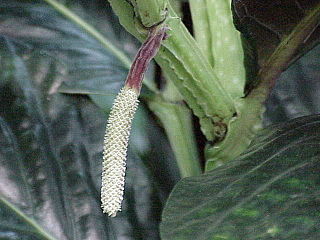
Piper, the pepper plants or pepper vines, is an economically and ecologically important genus in the family Piperaceae.

Black pepper is a flowering vine in the family Piperaceae, cultivated for its fruit, which is usually dried and used as a spice and seasoning. The fruit is a drupe (stonefruit) which is about 5 mm (0.20 in) in diameter, dark red, and contains a stone which encloses a single pepper seed. Peppercorns and the ground pepper derived from them may be described simply as pepper, or more precisely as black pepper, green pepper, or white pepper.

The Piperaceae, also known as the pepper family, are a large family of flowering plants. The group contains roughly 3,600 currently accepted species in 5 genera. The vast majority of species can be found within the two main genera: Piper and Peperomia.

Aleurites moluccanus, the candlenut, is a flowering tree in the spurge family, Euphorbiaceae, also known as candleberry, Indian walnut, kemiri, varnish tree, nuez de la India, buah keras, godou, kukui nut tree, and rata kekuna.

A golok is a cutting tool, similar to a machete, that comes in many variations and is found throughout the Malay archipelago. It is used as an agricultural tool as well as a weapon. The word golok is used in Indonesia and Malaysia and in the Philippines. Both in Malaysia and in Indonesia, the term is usually interchangeable with the longer and broader parang. In the Sundanese region of West Java it is known as bedog.

Piper excelsum of the pepper family (Piperaceae) and commonly known as kawakawa, is a small tree of which the subspecies P. excelsum subsp. excelsum is endemic to New Zealand; the subspecies P. e. subsp. psittacorum is found on Lord Howe Island, Norfolk Island and the Kermadec Islands.
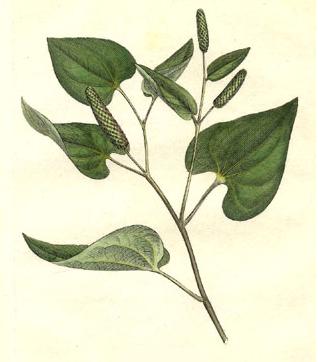
Long pepper, sometimes called Indian long pepper or pippali, is a flowering vine in the family Piperaceae, cultivated for its fruit, which is usually dried and used as a spice and seasoning. Long pepper has a taste similar to, but sweeter and less pungent than, that of its close relative Piper nigrum – from which black, green and white pepper are obtained.

More than 700 living languages are spoken in Indonesia. This figure indicates that Indonesia has about 10% of the world's languages, establishing its reputation as the second most linguistically diverse nation in the world after Papua New Guinea. Most languages belong to the Austronesian language family, while there are over 270 Papuan languages spoken in eastern Indonesia. The language most widely spoken as a native language is Javanese.
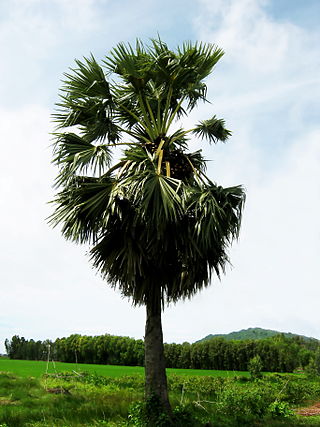
Borassus flabellifer, commonly known as doub palm, palmyra palm, tala or tal palm, toddy palm, lontar palm, wine palm, or ice apple, is a fan palm native to South Asia and Southeast Asia. It is reportedly naturalized in Socotra and parts of China.

Piper sarmentosum is a plant in the family Piperaceae used in many Southeast Asian cuisines. The leaves are often confused with betel, but they lack the intense taste of the betel leaves and are significantly smaller.

Piper chaba, commonly known as piper chilli, is a flowering vine in the family Piperaceae native to South and Southeast Asia. P. chaba is called chui jhal or choi jhal in the Khulna Division of Bangladesh, and the states of Tripura and West Bengal in India. P. chaba is found throughout India, and other warmer regions of Asia including Malaysia, Indonesia, Singapore and Sri Lanka.
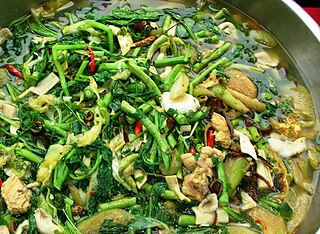
Kaeng khae is a curry of northern Thai cuisine.

Bumbu is the Indonesian word for a blend of spices and for pastes and it commonly appears in the names of spice mixtures, sauces and seasoning pastes. The official Indonesian language dictionary describes bumbu as "various types of herbs and plants that have a pleasant aroma and flavour — such as ginger, turmeric, galangal, nutmeg and pepper — used to enhance the flavour of the food."

Piper hooglandii, commonly known as kava, is a flowering plant in the family Piperaceae. The specific epithet honours Dutch botanist Ruurd Dirk Hoogland.

Sambal is an Indonesian chilli sauce or paste, typically made from a mixture of a variety of chilli peppers with secondary ingredients such as shrimp paste, garlic, ginger, shallot, scallion, palm sugar, and lime juice. Sambal is an Indonesian loanword of Javanese origin. It originated from the culinary traditions of Indonesia and is also an integral part of the cuisines of Singapore, Malaysia, Brunei, and Sri Lanka. It has also spread through overseas Indonesian populations to the Netherlands and Suriname.
Piper sylvaticum is a climber in the Piperaceae, or pepper, family. It is found in the northeast of the Indian subcontinent, and in Zhōngguó/China. The fruits are used in medicinal products.
Utania racemosa is a species of flowering plant in the family Gentianaceae. It occurs in Southeast Asia from Sumatera in Indonesia to the Andaman Islands in India. Its wood is used for timber and fuel.
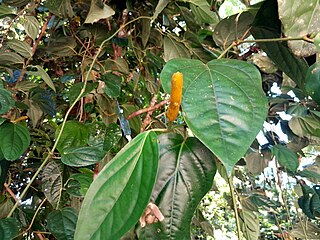
Piper mestonii, commonly known as Queensland long pepper or simply long pepper, is an evergreen vine in the pepper family Piperaceae native to rainforests of New Guinea and Queensland, Australia.

Piper fungiforme is a plant in the family Piperaceae endemic to northeast Queensland, Australia.

Piper interruptum is a vine in the pepper family Piperaceae, native to the eastern parts of Southeast Asia and to Melanesia and Queensland.

















